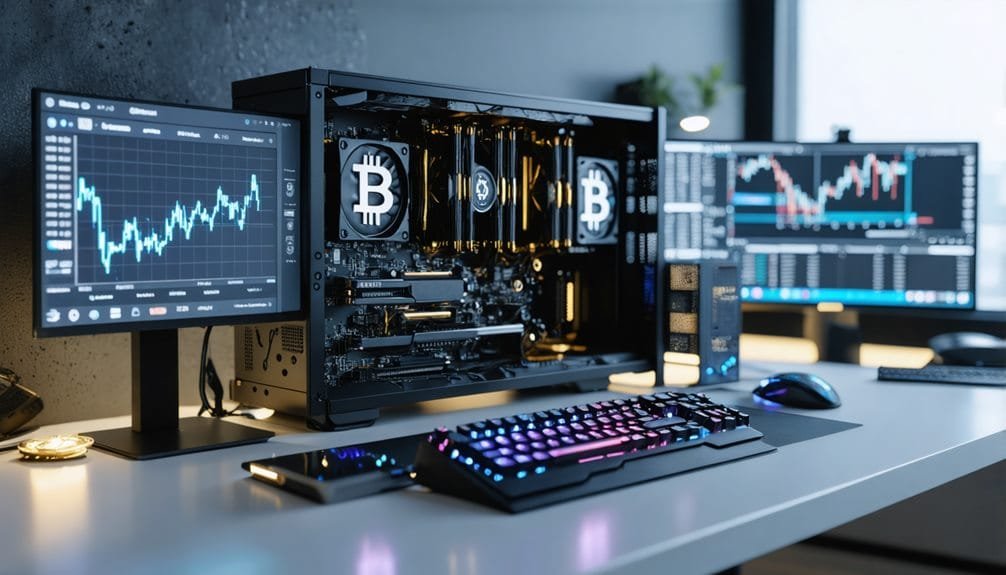Bitcoin mining involves using computational power to validate transactions and secure the network. To start, you’ll need specialized hardware—ASIC miners are highly efficient, while GPUs offer versatility. Choose software compatible with your hardware and designed for user-friendly monitoring. Joining a mining pool can enhance your chances of consistent rewards. Consider the electrical costs and the current market value of Bitcoin, as these greatly impact profitability. Additionally, maintain good records for tax implications, as mining rewards are taxable income. To gain further insights on optimizing your mining venture, you might consider exploring additional resources and information.
Table of Contents
Brief Overview of Step-by-Step Guide to Bitcoin Mining
- Understand Bitcoin mining as validating transactions and adding them to the blockchain, earning rewards in Bitcoin for successful efforts.
- Choose efficient mining hardware, such as ASIC miners for performance or GPUs for flexibility, based on your mining goals.
- Select compatible mining software with a user-friendly interface and support for your chosen mining pool to enhance operational efficiency.
- Analyze financial factors, including electricity costs, market volatility, and mining pool fees, to assess profitability before starting mining activities.
- Be aware of tax implications on mining rewards and consult experts to navigate the legal landscape surrounding cryptocurrency mining.
What is Bitcoin Mining?
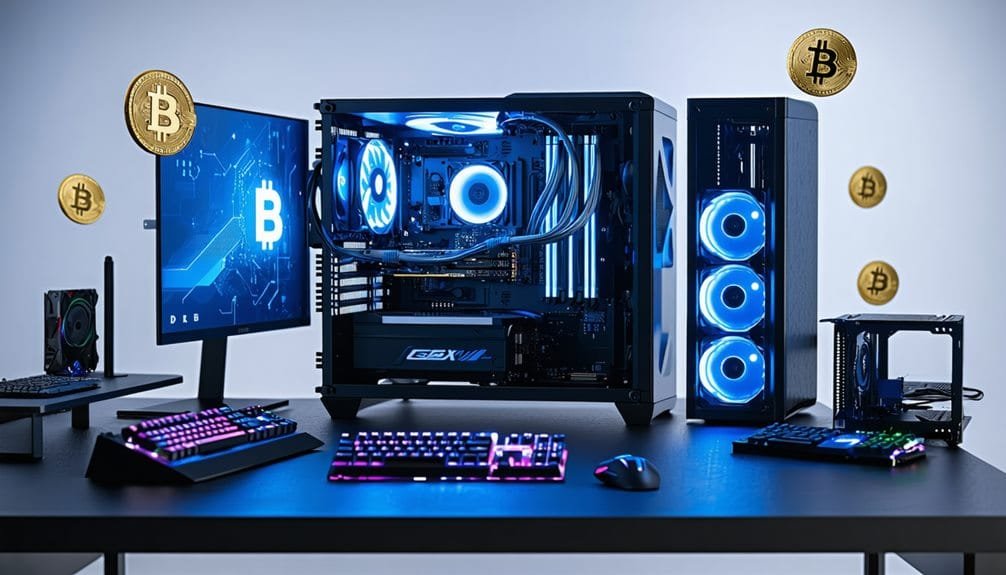
Bitcoin mining is the process of validating and adding transactions to the Bitcoin blockchain, ensuring the network’s integrity. It’s vital to understand what Bitcoin mining is, especially if you’re considering diving into this digital currency space. At its core, Bitcoin mining involves using computational power to solve complex mathematical problems. When miners successfully validate transactions, they add them to the blockchain and, in return, they earn Bitcoin as a reward, which raises questions about profitability.
You may wonder about the Bitcoin mining basics. First, you need reliable Bitcoin mining hardware, typically ASICs (Application-Specific Integrated Circuits), designed specifically for mining. These devices provide the necessary computational power to compete in the mining process. You’ll also need a digital wallet to store your earnings securely, protecting your assets from potential threats.
Joining a mining pool can enhance your chances of earning rewards, as it allows you to collaborate with others, sharing computing resources. It’s important to install compatible mining software and configure it correctly to connect to your chosen pool.
As you begin this journey, keep in mind the costs associated with electricity and hardware. Many ask, “Is Bitcoin mining profitable?” While it can be, the profitability hinges on factors like electricity rates, hardware efficiency, and Bitcoin’s market value. By understanding these significant elements, you can navigate the world of Bitcoin mining more safely and effectively.
How Does Bitcoin Mining Work?
To understand how Bitcoin mining works, you need to grasp the role of blockchain technology and the significance of mining pools. Blockchain acts as a decentralized ledger, recording all transactions securely, while mining pools allow you to combine resources with other miners, enhancing your chances of earning Bitcoin. By collaborating in a pool, you share the rewards, making it a practical approach in the competitive world of crypto mining.
The Role of Blockchain in Mining
A solid understanding of blockchain technology is essential for grasping how mining operates. At its core, blockchain is a decentralized ledger that records all transactions made with Bitcoin. When you engage in bitcoin mining, you validate these transactions by solving complex mathematical problems. This process not only confirms the legitimacy of transactions but also adds them to the blockchain, ensuring they are secure and immutable.
In bitcoin mining basics, each time you successfully mine a block, you’re rewarded with new bitcoins and transaction fees. However, you should consider the risks of bitcoin mining, such as fluctuating market values and the high energy consumption associated with mining operations. The efficiency of your mining hardware and the configuration of your setup can greatly impact your profitability.
Importance of Mining Pools
Mining pools play an essential role in enhancing the efficiency of Bitcoin mining operations. By joining bitcoin mining pools, you collaborate with other miners, combining your resources to increase your chances of successfully solving blocks. This pooling of efforts allows you to receive more consistent rewards, which can greatly improve your bitcoin mining profitability compared to mining solo.
When you participate in cryptocurrency mining pools, your work is aggregated with that of others, leading to faster block discoveries. This means you can earn smaller, but more frequent payouts, reducing the variance in your earnings. For those wondering how to mine bitcoin effectively, joining a mining pool is often a preferred strategy. It mitigates the risks associated with mining alone, especially given the high competition and the increasing difficulty of mining.
Furthermore, mining pools often provide access to valuable resources and support, making it easier for you to understand the intricacies of the mining process. Ultimately, understanding why mine bitcoin through pools can lead to a more stable and rewarding mining experience, allowing you to focus on maximizing your efforts with less uncertainty.
Why Mine Bitcoin?
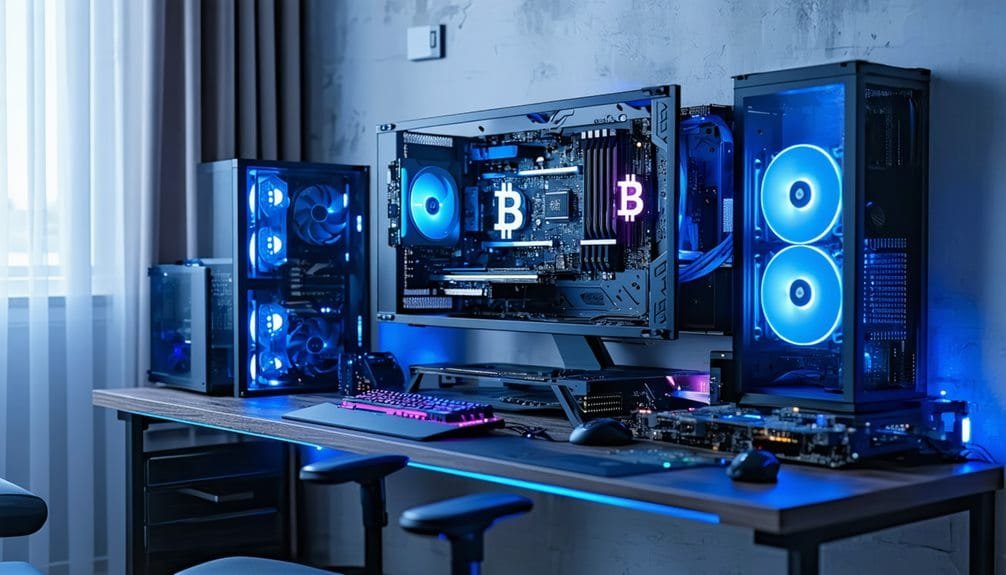
When you consider mining Bitcoin, it’s crucial to understand the incentives at play. By participating, you can earn block rewards and transaction fees, which can greatly enhance your earnings. Additionally, your efforts help secure the network, making it more robust and trustworthy for all users.
Incentives and Block Rewards
Understanding the incentives behind Bitcoin mining is fundamental for anyone evaluating this venture. One of the primary motivations is the block rewards miners receive for validating transactions. Currently, miners earn 6.25 BTC per block, a considerable sum. However, this reward decreases during Bitcoin halving events, which occur approximately every four years. As the block reward reduces, it impacts mining incentives, making it essential for you to reflect on the long-term profitability of your efforts.
Mining incentives also include transaction fees, which can add to your earnings. Yet, you must factor in bitcoin mining costs, such as hardware, electricity, and maintenance. As the network becomes more competitive, these costs can greatly influence your bottom line.
Looking ahead, the future of Bitcoin mining may become increasingly challenging due to rising difficulty levels and halving events. Consequently, it’s important to stay informed about market trends and technological advancements. By understanding the dynamics of block rewards and mining incentives, you can make more informed decisions about your mining strategy. This knowledge could enhance your chances of success in the evolving world of Bitcoin mining.
How to Mine Bitcoin?
To start mining Bitcoin, you’ll need to set up your mining hardware, typically using ASICs for the best results. After that, choosing and installing the right mining software is essential, as it connects your hardware to the network and manages your mining activity. By following these steps, you’ll be well on your way to participating in the Bitcoin mining process.
Setting Up Mining Hardware
Before diving into Bitcoin mining, selecting the right hardware is vital for your success. You’ll need to decide between ASIC mining and GPU mining, as both have their advantages. ASIC miners are specifically designed for Bitcoin mining, offering superior performance and energy efficiency. If you’re looking for a more versatile option, GPU mining allows you to use graphics cards for mining various cryptocurrencies but may not yield the same results as ASICs.
When choosing bitcoin mining hardware, consider factors like hash rate, power consumption, and initial cost. A higher hash rate means more potential earnings, but it also often comes with higher energy costs. Crypto mining equipment should be reliable to minimize downtime and guarantee consistent operation.
Another significant consideration is cooling solutions, as mining generates significant heat. Proper ventilation and cooling can prolong the lifespan of your hardware.
Additionally, make certain you have a secure digital wallet to store your earnings safely. Once you’ve selected and assembled your mining hardware, you’ll be well on your way to participating in the Bitcoin network. Remember, monitoring performance and managing electricity costs are vital for maximizing profitability in this competitive space.
Choosing and Installing Mining Software
Selecting the right Bitcoin mining software is vital for your mining success. In Illinois, where questions about the legality of bitcoin mining arise, it’s important to verify you’re using software that adheres to local regulations. You’ll want to choose software that efficiently utilizes your mining hardware and offers security features to safeguard your earnings.
Here’s a list of key factors to take into account when selecting your software:
- Compatibility: Confirm it works with your ASIC or GPU hardware.
- User Interface: A simple interface can help you monitor your mining easily.
- Community Support: Look for software with active forums or user groups.
- Mining Pool Integration: Choose software that connects seamlessly with your chosen mining pool.
- Performance Metrics: Good tools should provide real-time stats on your mining progress and efficiency.
Moreover, keep in mind the bitcoin mining environmental impact. As concerns grow about sustainability, selecting eco-friendly crypto mining tools can help you mine responsibly. Understanding whether bitcoin mining is legal in your jurisdiction will also keep you compliant and safe in your mining endeavors.
Is Bitcoin Mining Legal?

When you’re considering Bitcoin mining, it’s vital to understand its legal status, which varies considerably across different regions. In India, for instance, the legal framework is still evolving, and you may face specific tax implications that could impact your operations. Staying informed about local regulations and compliance requirements is essential to guarantee that your mining activities remain within the law.
Legal Status of Bitcoin Mining in India
The legal status of Bitcoin mining in India has been a point of contention, as the government continues to navigate the intricate world of cryptocurrencies. Currently, there’s no specific law that outright bans or regulates Bitcoin mining in India. However, it’s vital to stay updated, as policies can change rapidly.
Here are some key points to reflect on regarding the legal landscape of Bitcoin mining in India:
- Regulatory Uncertainty: The government has not provided clear guidelines for miners, leading to confusion.
- Energy Regulations: Mining consumes significant electricity, which may draw scrutiny from local authorities regarding energy use.
- Potential Future Regulations: Analysts suggest that regulations could emerge, impacting how mining operations are conducted.
- Banking Restrictions: In the past, banks have hesitated to provide services to cryptocurrency businesses, affecting miners.
- Legal Risks: Engaging in mining without clarity on regulations may expose you to legal risks.
Given these factors, if you’re deliberating Bitcoin mining in India, it’s important to consult legal experts and stay informed about the evolving regulatory environment. This approach helps guarantee that your mining activities remain compliant and secure.
Tax Implications of Mining
Understanding the tax implications of Bitcoin mining is essential for anyone venturing into this space. When you mine Bitcoin, the rewards you receive are often viewed as taxable income by tax authorities in various jurisdictions. This means you’ll need to report the fair market value of the mined Bitcoin at the time of receipt as income. Additionally, when you eventually sell or exchange that Bitcoin, any profit you make may be subject to capital gains tax.
It’s imperative to keep accurate records of your mining activities, including the costs of electricity, hardware, and any other relevant expenses. These can potentially offset your taxable income. Different countries have different regulations, so it’s advisable to consult a tax professional familiar with crypto mining taxes in your area.
Failing to comply with tax obligations can lead to penalties, so being proactive about your tax responsibilities is crucial. Remember, staying informed and compliant not only protects your earnings but also guarantees you’re participating in this innovative space safely. Ultimately, understanding these tax implications will help you navigate the complexities of Bitcoin mining more effectively.
How to Choose Hardware for Bitcoin Mining?
When choosing hardware for Bitcoin mining, you’ll often face a critical decision between ASICs and GPUs. ASICs, designed specifically for mining, typically offer superior efficiency and performance, while GPUs provide versatility for other applications. Understanding the strengths and weaknesses of each option is essential to making an informed choice that aligns with your mining goals.
ASIC vs. GPU: Which is Better?
Choosing the right hardware for Bitcoin mining is essential, as it can greatly impact your profitability and efficiency. You’ll often face the choice between ASIC and GPU mining. ASIC (Application-Specific Integrated Circuit) miners are highly specialized machines designed specifically for Bitcoin mining, offering superior efficiency compared to GPUs. However, GPUs (Graphics Processing Units) are versatile and can mine a variety of cryptocurrencies, making them a flexible choice for some miners.
When deciding which hardware to use, consider the following factors:
- Efficiency: ASIC miners typically outperform GPUs in hash rate and energy consumption.
- Cost: ASICs can be more expensive upfront, but they may yield better returns in the long run.
- Flexibility: GPUs allow you to switch between different cryptocurrencies, which can be advantageous.
- Availability: ASICs may be harder to find due to high demand, while GPUs are more readily accessible.
- Longevity: GPUs may remain useful for gaming or other tasks, while ASICs are dedicated solely to mining.
Ultimately, your choice should align with your goals and risk tolerance in the ever-evolving crypto mining landscape.
Is Bitcoin Mining Worth It?
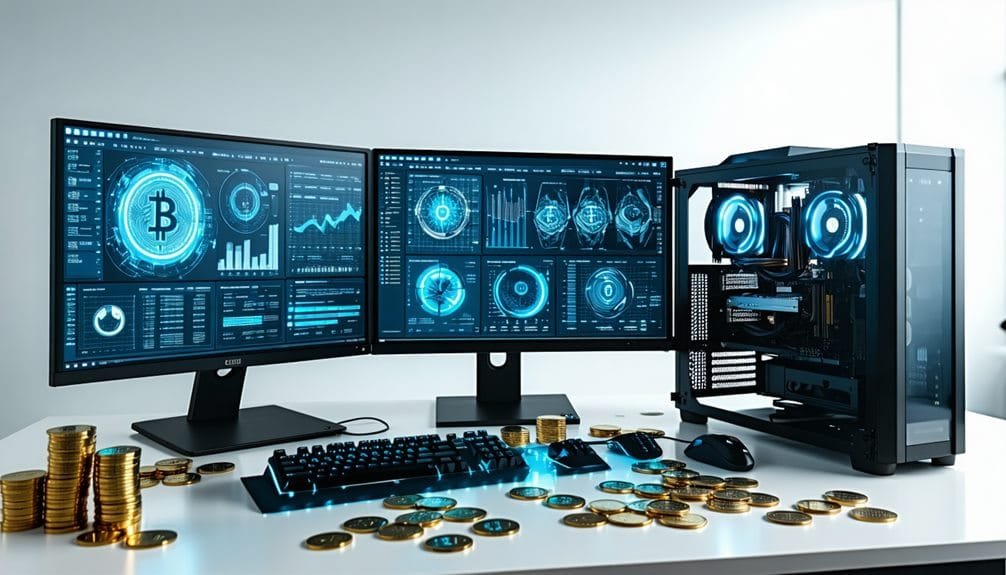
When considering whether Bitcoin mining is worth it, you need to assess several factors affecting profitability, like electricity costs and hardware investment. Using a Bitcoin mining ROI calculator can help you estimate potential returns based on current market trends. By analyzing these elements, you can make a more informed decision about your mining endeavors.
Factors Affecting Profitability
Several factors considerably impact the profitability of Bitcoin mining, making it essential to understand what influences your potential earnings. To navigate this complex landscape, consider the following key variables:
- Electricity Costs: Your electricity rate can notably affect your overall mining costs. Lower rates enhance profitability.
- Network Difficulty: As more miners join the network, the difficulty increases, making it harder for you to earn rewards. This can decrease profitability.
- Market Volatility: The fluctuating price of Bitcoin impacts your earnings. A drop in price can quickly turn profits into losses.
- Mining Hardware: The efficiency and power of your mining equipment play a vital role. ASIC miners, for instance, offer better performance than older hardware.
- Mining Pool Fees: If you join a mining pool, be mindful of their fees. While pools increase your chances of earning, high fees can eat into your profits.
Bitcoin Mining ROI Calculator
Understanding the factors affecting your profitability is only part of the equation; you also need a reliable way to assess whether Bitcoin mining is worth the investment. A Bitcoin ROI Calculator is an essential tool for this purpose. It helps you estimate your potential returns by considering various factors, including hardware costs, electricity expenses, and the current value of Bitcoin.
When using a Bitcoin ROI Calculator, input your initial investment for mining equipment, ongoing operational costs, and the expected mining output based on your hardware’s hash rate. This calculator will then provide you with an estimated timeframe for recouping your investment and potential profit margins.
Additionally, utilizing other crypto mining tools can enhance your understanding of profitability. These tools can analyze market trends, electricity rates, and even the performance of mining pools. By combining these resources, you’ll gain a clearer picture of whether diving into Bitcoin mining aligns with your financial goals and risk tolerance. Remember, mining isn’t just about the technology; it’s also about making informed decisions. So, take the time to evaluate all factors before committing your resources.
Risks of Bitcoin Mining
When you consider the risks of Bitcoin mining, environmental concerns and security threats are key factors. The energy consumption associated with mining can contribute considerably to carbon emissions, raising ethical questions about sustainability. Additionally, the potential for cyber attacks or hardware failures can lead to financial losses, making it essential to understand these challenges before you start.
Environmental Concerns
As the popularity of Bitcoin mining surges, so do the environmental concerns tied to its energy-intensive nature. The process requires substantial electricity, often leading to increased carbon emissions from fossil fuel sources. This impact raises questions about sustainability and the long-term viability of mining practices.
Here are some key points to reflect on regarding the Bitcoin mining environmental impact:
- High Energy Consumption: Mining operations consume vast amounts of electricity, straining local grids and resources.
- Carbon Footprint: Depending on the energy source, Bitcoin mining can greatly contribute to greenhouse gas emissions.
- E-Waste Generation: The hardware used in mining, such as ASICs, has a limited lifespan, contributing to electronic waste.
- Water Usage: Cooling systems for mining rigs can lead to excessive water consumption in certain areas.
- Biodiversity Impact: Large mining facilities can disrupt local ecosystems and wildlife habitats.
Understanding these concerns is vital for anyone contemplating Bitcoin mining. It’s important to weigh the benefits against the environmental implications and to explore greener alternatives or practices that minimize energy use and carbon output.
Security and Cyber Threats
In the world of Bitcoin mining, security is a paramount concern that can profoundly impact your operations. Cyber threats like hacking, malware, and unauthorized access to your mining rigs pose significant risks. As you engage in Bitcoin mining, it’s vital to understand these potential dangers and implement effective strategies to safeguard your assets.
First, make sure that your mining hardware is secured. Use strong passwords and enable two-factor authentication on all accounts related to your mining activities. This added layer of protection can deter unauthorized access. Next, be cautious about the software you install. Only download mining software from reputable sources, as malicious programs can compromise your system and steal your earnings.
Furthermore, joining a mining pool can offer some security benefits, but it’s important to choose a well-established and trusted pool. Research their security measures and community reputation before committing. Regularly monitor your mining operations for any unusual activity, as early detection can help mitigate potential threats.
The Future of Bitcoin Mining
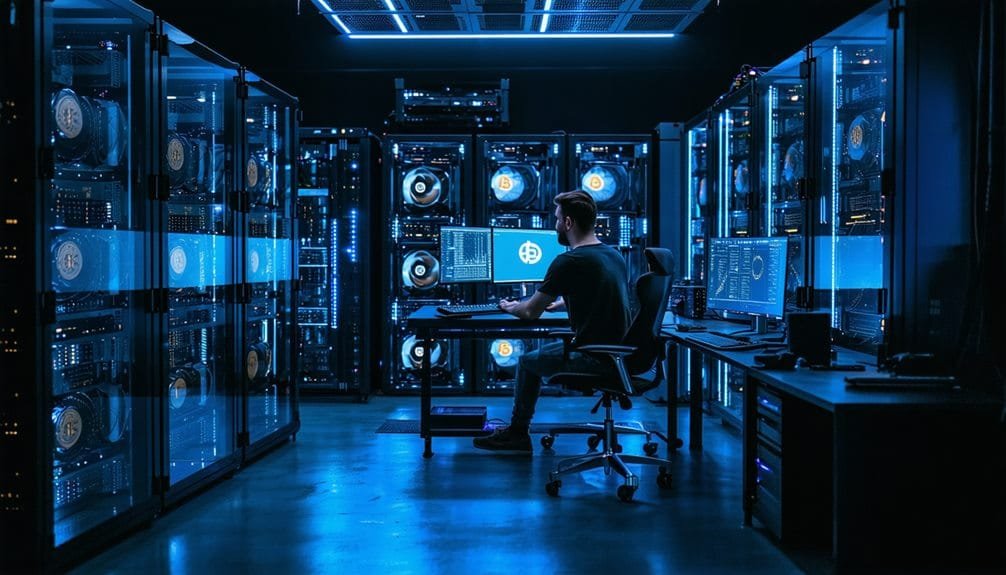
As you look ahead to the future of Bitcoin mining, you’ll notice a significant shift towards renewable energy solutions that aim to reduce environmental impact. Innovations in mining hardware are also emerging, promising enhanced efficiency and lower energy consumption. Together, these trends not only shape the sustainability of crypto mining but also influence its profitability and accessibility for miners like you.
Renewable Energy Solutions for Mining
The future of Bitcoin mining increasingly leans toward renewable energy solutions, transforming the industry into a more sustainable endeavor. As concerns about the environmental impact of mining grow, adopting green practices becomes essential. By integrating renewable energy sources, you can lower energy costs and reduce the carbon footprint associated with mining activities.
Consider these key points when exploring renewable energy mining:
- Solar Power: Utilizing solar panels can harness sunlight, providing a clean energy source for your mining operations.
- Wind Energy: Wind turbines can generate electricity, especially in areas with consistent wind patterns, making it a viable option for miners.
- Hydropower: Leveraging water flow to create energy is both efficient and renewable, often resulting in lower operational costs.
- Geothermal Energy: Tapping into the Earth’s internal heat can provide consistent energy, minimizing reliance on fossil fuels.
- Biomass: Utilizing organic materials can generate power while promoting waste reduction.
Evolution of Mining Hardware
With the push for renewable energy solutions reshaping the Bitcoin mining landscape, advancements in mining hardware are becoming increasingly essential. As you explore Bitcoin mining hardware innovations, you’ll notice the rise of more efficient ASICs (Application-Specific Integrated Circuits). These specialized devices are designed solely for Bitcoin mining, offering enhanced performance while consuming less energy. This is critical, given that energy costs greatly impact mining profitability.
Crypto hardware trends indicate a shift towards sustainable and cost-effective solutions. Manufacturers are focusing on creating devices that not only boost hash rates but also minimize power usage. This evolution is important for your safety and investment, as more efficient hardware reduces the risks associated with high energy consumption and potential overheating.
Moreover, as technology progresses, you can expect future mining rigs to incorporate advanced cooling systems and smarter algorithms, further optimizing performance. By keeping an eye on these developments, you’ll be better equipped to make informed decisions when choosing your mining setup. Ultimately, understanding the evolution of mining hardware will help you navigate the competitive world of Bitcoin mining, ensuring both efficiency and safety in your endeavors.
Frequently Asked Questions
How to Do Bitcoin Mining for Beginners?
To start Bitcoin mining, you’ll need reliable hardware, like an ASIC miner, for effective performance. First, set up a secure digital wallet for storing your mined coins. Joining a mining pool can enhance your chances of earning rewards by combining your efforts with others. Install compatible mining software and configure it properly. Finally, keep an eye on your mining progress and electricity costs to guarantee your operations remain profitable in this competitive environment.
How Long Does It Usually Take to Mine 1 Bitcoin?
When you’re mining Bitcoin, the time it usually takes to mine one Bitcoin can vary widely. Under ideal conditions, you might mine 1 Bitcoin in about 16 minutes, as it takes roughly 10 minutes to mine one block yielding 6.25 BTC. However, due to network difficulty and competition, it often takes much longer, especially if you’re mining solo. Joining a mining pool can help improve your odds and provide more consistent rewards.
Can You Mine Bitcoin for Free?
You can’t really mine Bitcoin for free. The process requires significant investment in specialized hardware, like ASIC miners, which can be pricey. While some cloud mining platforms seem affordable, they often come with hidden fees that can cut into your profits. Even using a personal computer isn’t feasible due to the high difficulty level of mining. Ultimately, without substantial investment, the chances of mining Bitcoin profitably are slim to none.
How Much Do You Need to Mine One Bitcoin?
To mine one Bitcoin effectively, you’ll need powerful ASIC hardware, which can cost anywhere from $1,000 to over $10,000. You’ll also face significant electricity expenses, averaging between $0.10 and $0.25 per kWh, making energy efficiency vital. The current block reward is 6.25 BTC, but remember, it’s halved every four years. Joining a mining pool can enhance your chances of earning rewards, given the competitive nature of Bitcoin mining.
Summarizing
In summary, starting your Bitcoin mining journey requires careful consideration of hardware, software, and operational costs. By understanding the mechanics behind mining and the value of joining a pool, you can enhance your profitability. While mining presents both opportunities and risks, staying informed about technological advancements and market trends will be essential. With the right approach, you can navigate this competitive landscape effectively and make informed decisions that align with your financial goals.


